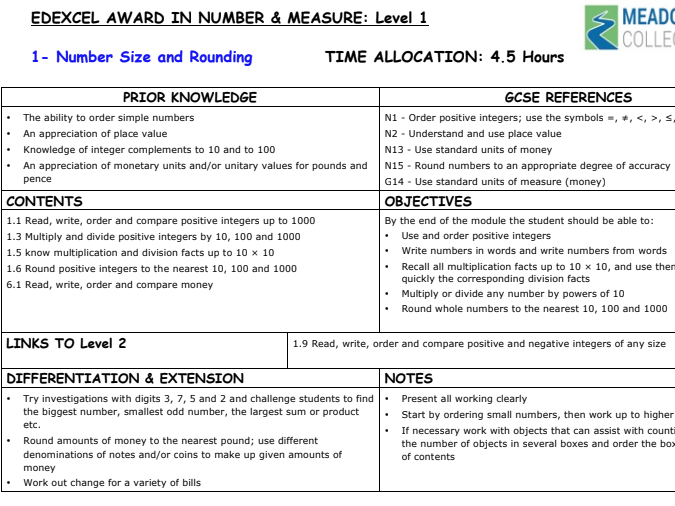
71Uploads
9k+Views
2k+Downloads
All resources

Audiences
A resource to teach about Audiences. Used for the BTEC Tech Award in Creative Media Products, Component 1

GCSE Problem Solving: "UNPACK" problems (Bundle)
This series of workbooklets provide GCSE exam questions for students to tackle using the “UNPACK” method.
U = UNderline important information about the question
N = UNderstand what the question is asking
P = What maths Processes will I be using?
A = My Answer to th questions
C = Have I Checked my work?
K = I Know my answer makes sense
The “UNPACK” booklet and PPT explains to students how to use this method, with examples, prior to them attmepting to use this method for themselves in:-
Problem Solving with Shape, Space and Measure
Problem Solving with Ratio and Proportion
Problem Solving with Probability
Problem Solving with Number
Problem Solving with Data and Statistics
Problem Solving with Algebra

Edexcel Award in Number and Measure Level 1: Scheme of Work and Staff/Student Assessment Trackers
Scheme of Work, Staff Tracker and Student Tracker for Edexcel Award in Number and Measure: Level 1
Scheme of Work:- Provides detailed lesson plan for each of the 13 units in the Level 1 qualification, and also provides links to the Level 2 and GCSE courses. Objectives, Differentiation and Extension points are also provided.
Staff and Student Tracker:- Provides a breakdown of the learning objectives for each Unit, so that staff and students can track their understanding and progress throughout the course.

Key Stage 3 Topic Booklets
Units of work for use with Key Stage 3 (or low-ability KS4) to boost basic mathematical and numeracy skills. Ideal for using in small groups or for intervention work.
Section 1: Number
Section 2: Mental Methods 1
Section 3: Mental Methods 2
Section 4: Square and Square roots
Section 5: Number Patterns
Section 6: Negative Numbers
Section 7: Fractions
Section 8: Perimeter, Area and Volume
Section 9: Basic Probability
Section 10: Ratio and Proportion
Section 11: Averages
Section 12: Types of Data and Representation

BTEC Tech Award in Creative Media: Component 1
A handbook and workbook for students to use for Component 1: Exploring Media Products.
It has activities which cover the learning aims for Component 1 preparing them for the first assessment task.

Congruence & Similarity
Learning Objectives:-
Apply the concepts of congruence and similarity
Use the basic congruence criteria for triangles

Vectors & Transformations
Learning Objectives:-
How to generate a Vector, and Add and Subtract vectors
Consider transformations rotation, reflection, translation and enlargement (including fractional scale factors)

Properties of Polygons
Learning Objectives:-
Derive and apply properties of polygons (and know their names)
Correctly use geometrical terms, label triangle sides and angles and draw diagrams from written descriptions
Calculate interior and exterior angles in regular polygons
Identify lines or symmetry and rotational symmetry order

Integers
Learning Objectives:-
• Recognising place value
• Ordering whole numbers
• Recall all positive integer complements to 100
• Understanding place value and round to a given power of 10
• Round to the nearest integer
• Round to a given number of decimal places
• Estimate answers to problems involving decimals
• Round a number to one significant figure

Bearings & Maps
Learning Objectives:-
To find a bearing from A to B
To find a return bearing from B to A
To understand the points on a compass and the angles of each point
To use scale to work out distance from one bearing to another

Equations
Learning Objectives:-
• Solve linear equations with one unknown on one side
• Derive equations from geometric and other forms of problem
• Solve two linear simultaneous equations in two variables algebraically

Indices
Learning Objectives:-
Simplify expressions involving sums, products and powers, including using index laws
Calculate with negative and fractional indices

Inequalities
Learning Objectives:-
Represent the solution of a linear inequality on a number line
Work out an inequality from a number line
Solving Inequalities

Straight-line Graphs
Learning Objectives:-
Be able to name and draw horizontal and vertical equations
Be able to draw an equation onto axis using the table method
Identify and interpret gradients and intercepts of linear functions, both algebraically and graphically.

Simplifying, Factorising & Brackets
Learning Objectives:-
Simplify algebraic expressions by collecting like terms (adding and subtracting)
Expanding brackets
Take out common factors to factorise
Factorising and expanding quadratics

Cumulative Frequency, Box Plots & Comparing Distributions
Learning Objectives:-‐
Construct and interpret cumulative frequency
diagrams (for grouped discrete as well as
continuous data)
Interpret and construct box plots
Use measures of central tendency and measures
of spread to interpret, analyse and compare the
distributions of data sets

Data, Charts & Diagrams
Learning Objectives:-‐
Be able to categorise different types of data,
including primary, secondary, discrete, continuous
Interpret and construct charts and diagrams
(including bar charts and pictograms) for
categorical data
Interpret and construct pie charts for categorical
data
Construct and interpret histograms with equal
class widths (for grouped discrete as well as
continuous data)
Use graphical representations to interpret,
analyse and compare the distributions of data sets
from univariate distributions (discrete, continuous
and grouped)

Histograms
Learning Objectives:-
Construct and interpret histograms with equal class widths (for grouped discrete as well as continuous data)
Construct and interpret histograms with unequal class widths (for grouped discrete as well as continuous data)




















